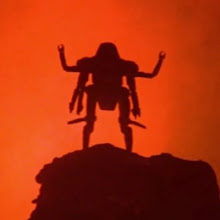
"The way I see it, we've got what, we've got 650 years of knowledge on these guys. If we put our heads together, there's no reason why we shouldn't be able to get out of here and home in 20 minutes," Chris Johnston (Paul Walker), noting the advantages of being a citizen of 2003 trapped in the year 1357, in the 2003 film, Timeline, based upon the 1999 novel of the same name by Michael Crichton. How's that for chronological snobbery? Would that time travel were possible; cinema-goers could travel back to 2003 and prevent the production of the uninspiring time travel movie, Timeline, based upon Crichton's novel but mostly cinematic cliches.
The film's plot is relatively straightforward. Archaeologists working a dig at Castlegard, France make a curious discovery in a medieval monastery. In a room no one has visited in six centuries, they find a modern bifocal lens and a written plea for help from the dig's leader, the missing Professor E. A. Johnston (Billy Connolly), apparently trapped in the year 1357. To investigate, Johnston's team, comprised of his son Chris and archaeologists Kate Ericson (Frances O'Connor), Andre Marek (Gerard Butler), François Dontelle (Rossif Sutherland) and physicist Josh Stern (Ethan Embry), travels to the headquarters of ITC, the company has been funding their project. Thereupon, ITC officials admit that they inadvertently discovered a wormhole which can transport people directly to Castlegard in 1357. Professor Johnston chose to venture back to the past and has remained there long enough to lose his ability to return.
What makes a proper time travel movie worth its salt is the presence of anachronisms, or depending on the nature of the story, parachronisms. Directed by Richard Donner, with a script by Jeff Maguire and George Nolfi, the film simply cannot capitalize upon its premise. Upon traveling back in time six centuries, the characters refuse to take meaningful advantage of their anachronistic knowledge and skills; they make but a few amusing remarks about what they observe in the past. So busy are they being chased by villains that the movie becomes just another a tired formulaic action picture which just so happens to feature time travelers.
One of several weak attempts at past/present misunderstandings is an exchange played for romantic comedy; Marek, after rescuing a Frenchwoman named Claire (the lovely Anna Friel, currently playing a twee sweetie on TV's "Pushing Daisies"), has the following conversation:
Marek: Are you, uh... married?
Lady Claire: No. We've been fighting the English since before I was born. There's no time for marriage.
Marek: Of course. Are you, uh... with... anyone?
Lady Claire: Am I with anyone?
Marek: Yeah.
Lady Claire: I'm with you.
Marek: I know, I know. What I mean is, is there, is there someone, is there someone... that you see?
Lady Claire: Do I see?
Marek: Yeah.
Lady Claire: [Looks around] Uh, nobody... It is possible they are hiding on the shore or... in the woods. They could be anywhere.
Marek: We're speaking the same language, but you don't understand a word I'm saying, do you?
Lady Claire: No.
 Lady Claire (Anna Friel) endures the past, as we all must.
Lady Claire (Anna Friel) endures the past, as we all must.However, the film contradicts itself when it decides that history can indeed be changed. Much ado is made of a battle between the French and the English, who are holding a French fortress at Castlegard on the very day the time travelers arrive. Apparently, as history originally recorded the battle, the English were overpowering the French until the English made the fatal mistake of killing Lady Claire and hanging her body from atop the fortress. This act, according to dialogue-as-exposition at the film's beginning, galvanized the French forces and ultimately resulted in the French victory and the destruction of the fortress. However, as the film progresses, Lady Claire's originally fate is forestalled by Marek, who saves her life and therefore changes history. Marek remains in the past, marries Lady Claire, has children with her, and their undying affection ends up as the art carving on the aforementioned sarcophagus. (Is a sarcophagus the best way to symbolize undying affection?) Yet the sarcophagus remains as it was at the beginning of the film, in the timeline in which Lady Claire died during the battle.
All of the evidence of their romp into the past was present in the archaeological record at the beginning of the film and before their trek, which nicely implies fate and that time travel is proof of predestination. However, the initial historical accounts of the battle cannot be reconciled with what actually occurs at the film's climax. Pick a theory, Timeline, and stick with it.





No comments:
Post a Comment